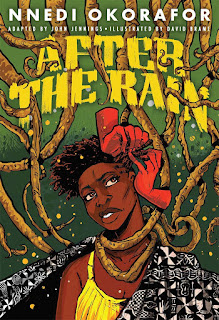After the Rain is the first book to come out of Abrams' Megascope imprint, headed up by John Jennings. The book's colophon page includes this description: "Megascope is dedicated to showcasing speculative works by and about people of color, with a focus on science fiction, fantasy, horror, and stories of magical realism... Megascope will serve as a lens through wwhich we can broaden our view of history, the present, and the future, and as a method by which previously unheard voices can find their way to an ever-growing diverse audience." The story in After the Rain, not surprisingly then, is an adaptation of Nnedi Okorafor's 2013 short story, "On the Road."
The story opens with Chioma, a former Chicago cop, visiting her family in Nigeria. After a seemingly random encounter with a young boy with so many visible wounds that he shouldn't even be alive, Chioma finds herself dealing with a series of increasingly horrific nightmares. Both imagined and real. Though somewhat vague at first, these horrors seem to coalesce in form more and more until she finds herself dragged out onto the street, with her hands chopped off, and staring down a kaiju-sized monster made out of asphalt and wearing an Agbogho Mmuo mask. She manages to escape, only to confront her own mortality -- and morality -- by way of coming to terms with some memories of her own past. She eventually leaves Nigeria for her home, more appreciative and embracing of her dual-heritage.
That description doesn't really do the story justice, of course. It's hardly the simplisitic plot structure of good conquering evil that you might find in most mainstream stories. Which is a large part of the point. Commercial storytelling has very strongly embraced Joseph Campbell's "hero's journey" concept so much so that it's hard to find any story from the past several decades that doesn't rely on that structure to some degree. (I initially mistook the 2004 film Steamboy as a blatant rip-off of the original Star Wars, before I realized that, no, they were both just relying on the same structure that Campbell outlined.) There's nothing wrong with Campbell's structure per se, but it's relied on so heavily and so exclusively, it makes a lot of commercial storytelling boring.
After the Rain largely eschews that structure, though. While Chioma does go on a hero's journey of sorts, it incorporates a fair dose of Nigerian traditions, making this stand out considerably. I haven't read Okorafor's original to speak to how faithfully Jennings and artist David Brame have adapted it here, but it certainly flowed smoothly on its own. Brame's style isn't dissimilar to Jennings' own, so I expect they had an easy working relationship, at least as far as the storytelling is concerned. I found it particularly interesting, too, that despite much of the book relying on Chioma's narration in the form of captions, it didn't feel as much like illustrated prose as I've seen with other graphic novels recently. I suspect this is in part because the narration is a little more necessary here since Chioma is by herself much of the time. When she's in the presence of others, it does pick up more with integrated dialogue.
Okorafor has already gotten some attention from her work on LaGuardia (with Tana Ford) and a variety of Black Panther related books from Marvel. Launching the Megascope line with a story of hers that is more centrally about her family's culture feels 100% appropriate, and I'm eager to see more works under this banner. After the Rain was released last month and retails for $22.99 US.
Now Available!
Blog Archive
-
▼
2021
(290)
-
▼
February
(23)
- Weekly Recap
- All-Negro Comics
- Is'nana the Were-Spider Showtime Review
- Unsounded Appreciation Post
- Just Us! Review
- Weekly Recap
- Comics Calendar
- What's Not So Funny About the Funnies?
- Leveraging the Past to Move into the Future
- STEM Comic
- Still No Lobo Reprints
- Weekly Recap
- We Need More Courage in Comics
- Walt Carr Follow-Up
- Ron Wilson Appreciation Post
- The Other History of the DC Universe #2 Review
- After the Rain Review
- Weekly Recap
- Comics Calendar
- Golden Legacy Harriet Tubman Review
- Black History Month Comic Suggestion
- The Impact of Judgment Day in 2021
- Harriet Tubman Fighter for Freedom Review
-
▼
February
(23)







0 comments:
Post a Comment